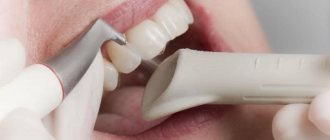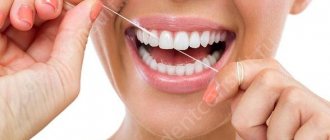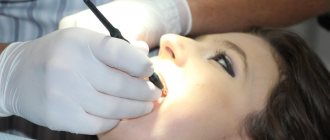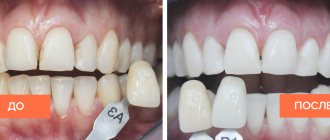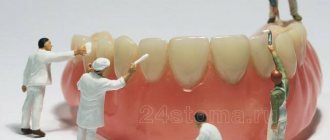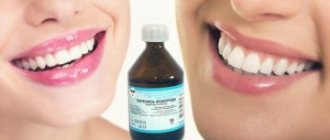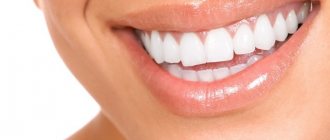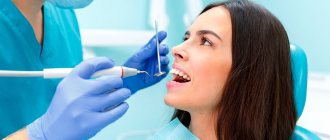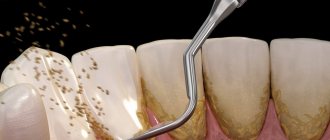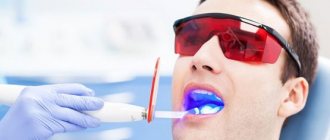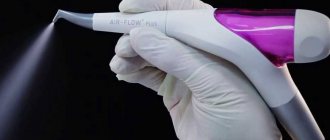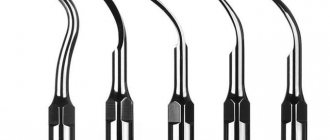- Hygienic teeth cleaning
- When is the best time to have your teeth professionally cleaned?
- Comprehensive professional teeth cleaning
- Professional teeth cleaning with ultrasound
- Cleaning teeth from plaque using the Air Flow method
- What is laser teeth cleaning?
- Manual teeth cleaning how the procedure is done
- Preventative care after comprehensive cleaning
- How and what to brush your teeth at home
- Our doctors
Plaque forms in the mouth due to harmful bacteria. If you do not take the necessary measures, this provokes the formation of tartar and the development of caries. Gum pathology may develop, leading to loosening and then tooth loss. To take care of their hygiene and health, professional hygienic teeth cleaning is necessary. To do this, it is worth visiting a dental clinic in Moscow.
The procedure effectively removes plaque, returns teeth to their natural white color, and prevents caries and gum disease. Professional care differs from home care in that the dental hygienist works with special tools. Plaque removal can be done in hard-to-reach places that a regular brush or even expensive toothpaste cannot do. The enamel layer is lightened by 1-2 tones, acquires a white color and a healthy appearance.
Deep hygienic dental cleaning prevents periodontal disease, damage to teeth by caries, their mobility, and loss.
When is the best time to have your teeth professionally cleaned?
You can tell when it’s time to see a doctor based on the following signs:
- an unpleasant putrid odor appeared from the mouth;
- the gums began to bleed, their subsidence was noticeable;
- itching or burning appears, pain is possible, especially when chewing food;
- tartar is visible visually;
- the color of the periodontium has changed.
Professional teeth cleaning will not harm your health, but there are contraindications:
- diseases of stomatitis, hepatitis, tuberculosis, as well as the presence of acute infections;
- the patient’s tooth enamel is too thin;
- intolerance to components used in cleaning;
- erosion, hypoplasia of tooth enamel.
Dental hygiene should not be done if the patient is under the age of eighteen. Professional hygiene is also contraindicated for HIV-infected people and AIDS patients. If there are diseases associated with difficulty breathing (asthma, epilepsy), sandblasting should not be carried out.
Cost of services
The Dentpremium Center for Expert Dentistry and Medicine offers professional teeth cleaning at an affordable price in Moscow. We offer the services of highly qualified specialists, modern methods, quality products and the latest technologies. One visit will be enough to get rid of complications and, as a result, get a beautiful smile. Our range of services also includes professional whitening.
How much teeth cleaning costs at Dentpremium dentistry depends on several factors, including the amount of work the specialist does, the complexity of the procedure and the method of carrying it out.
The cost in Moscow for using the Air Flow method for brushing teeth is on average 2000–3000 rubles. For professional teeth cleaning, prices for using a laser will be 5,000–6,000 rubles. It will be somewhat lower to do hygienic teeth cleaning with ultrasound in Moscow - 3000–4000 rubles.
You can see the cost of hygienic teeth cleaning at the Dentpremium clinic in the price list on the center’s official website. You also always have access to information about promotions and discounts that allow you to save on services.
Comprehensive professional teeth cleaning
The hygienic procedure is carried out using various professional methods. In a dental clinic in Moscow, the professional technique is individual for everyone. Regardless of the choice, the procedure is carried out in several stages:
- The dentist examines the patient's oral cavity. Based on the examination, a treatment plan is drawn up. If teeth cleaning is needed, the types and methods are determined by the hygienist.
- Chemical cleaning and removal of soft plaque with a professional toothbrush is performed.
- Removing hard plaque depends on the professional method chosen.
- The dentist uses dental strips to clean the sides of the teeth and polish them.
- The enamel is polished on all sides, all irregularities are eliminated. For this purpose, dentistry uses special brushes and professional cleansers.
- Deep cleaning of teeth is completed by applying a solution containing fluoride to the surface. The composition is applied briefly. Professional fluoridation strengthens the enamel, since it is weakened by the action of tartar. Teeth should be fluoridated to reduce their sensitivity and to prevent caries. Fluoridation can be done as a separate procedure.
After the hygiene procedure, the dentist gives the patient recommendations for professional oral care. This allows the effect to last longer.
Benefits of laser therapy
Laser therapy has many advantages over traditional treatments. Let's list the main advantages.
- The laser beam acts locally and briefly, without irritating the dental nerves or causing thermal reactions, so patients do not feel pain.
- The painlessness of the treatment allows you to eliminate or reduce the amount of painkillers, which is important for patients with intolerance or hypersensitivity to anesthesia.
- The laser does not produce unpleasant sounds characteristic of a drill - patients in the dental chair do not experience stress.
- In combined treatment regimens, laser radiation enhances the effects of medications and increases the effectiveness of treatment in general.
- Laser radiation is detrimental to pathological microflora, so there are no side effects, including inflammation and infection of healthy areas.
- The rehabilitation period is reduced by 2-3 times.
Professional teeth cleaning with ultrasound
If you influence tartar with ultrasonic waves, the process of getting rid of it becomes quick. The advantage of the ultrasound method is its antimicrobial and antibacterial effects.
Ultrasound is safe. Professional attachments are put on the emitter. They effectively remove plaque even in hard-to-reach areas. The result is exfoliation of tartar and its partial destruction. This is relevant when removing it from gum pockets - their treatment with an instrument can be painful and traumatic.
Thanks to ultrasound, such professional teeth cleaning guarantees a gentle effect on tooth enamel.
The hygienic procedure begins with exposure to an ultrasonic scaler at an angle. High frequency vibrations of ultrasonic waves remove deposits from the surface. At the same time, a flow of liquid is supplied. Together with ultrasonic vibrations, plaque and stone remains are washed away from periodontal pockets and interdental space. Hard tissues are lightened.
One session is enough to remove hard and soft deposits. Ultrasound teeth cleaning has almost no disadvantages. Exceptions to the effects of ultrasound - several contraindications:
- the presence of a pacemaker, severe cardiovascular disease or acute renal and hepatic failure in the patient;
- significant demineralization of tooth enamel;
- Ultrasonic teeth cleaning is prohibited if there is caries, which manifests itself in the form of multiple destructions;
- purulent diseases of the oral mucosa;
- the presence of orthopedic structures, especially metal ones.
Ultrasonic teeth cleaning has advantages:
- the versatility of the method, which allows ultrasound to remove deposits even in hard-to-reach places;
- antibacterial effect;
- no discomfort or pain during professional cleaning.
Treatment principle
Laser treatment is based on the principle of local exposure of the beam to a specific type of tissue. The beam does not affect neighboring areas. Targeted action allows you to remove carious and inflamed areas without affecting healthy enamel, gum tissue and dentin.
Carious tissues contain more moisture. Under the influence of the laser, moisture evaporates from them intensively - tissues affected by caries are gradually destroyed. In 3-5 therapy sessions, the doctor removes all diseased tissue without affecting healthy areas.
When treating periodontitis, it is necessary to remove infected areas that have changed their structure. To do this, the dentist treats the gums with a special solution that reacts with the affected cells. The solution stains the pathological areas, after which the laser acts on them. It evaporates and destroys them without damaging healthy areas.
Cleaning teeth from plaque using the Air Flow method
Unlike the ultrasonic method, Air Flow is the effect of air flow together with an abrasive on hard plaque. The abrasive material is soda, which is applied along with a thin stream of water. Adding menthol or lemon flavors to water gives a refreshing effect. Small particles of soda hitting the enamel due to the air flow do not harm the teeth. They effectively cope with soft and hard plaque in gum pockets and interdental spaces.
Brushing your teeth with water reduces the heating of enamel during the hygiene procedure. This professional method helps in effectively removing plaque and tartar, and thoroughly polishes the enamel.
In addition to being used as a comprehensive approach, air brushing is suitable in the following cases:
- implants, crowns, and other orthodontic structures are installed in the mouth, as well as if braces or implantation are to be removed;
- problems with gums at the initial stage or there is plaque that has not yet turned into tartar;
- severe pigmentation of teeth due to smoking, coffee abuse and foods with dyes.
The professional Air Flow technique is safe and painless, has a gentle effect, and cannot cause an allergic reaction.
If preventive teeth cleaning is not carried out as part of a comprehensive procedure, the effect will be short-lived. For a more lasting result, it should be done about four times a year.
Types and differences
Professional teeth cleaning can be done in a variety of ways. Each of them has both advantages and disadvantages. The patient’s wishes are taken into account when choosing a technique, but the final decision is made by the doctor, taking into account contraindications and the condition of the teeth.
Ultrasonic
The most effective way to remove solid deposits is ultrasonic cleaning. With its help, tartar is removed. A special device is used for this: it can be built into the dental unit or made as a separate unit. This is an ultrasonic scaler.
There is a working nozzle at the tip of the device. Its tip makes oscillatory movements at an ultrasonic frequency of 25-50 kHz. Additionally, water or an antiseptic solution is supplied to the nozzle. They enhance the cleansing effect due to cavitation - vibrations of water dipoles with the formation of bubbles. Excess fluid is removed using a saliva ejector.
Ultrasonic cleaning, when carried out correctly, does not damage the enamel. It allows you to remove not only tartar, but also bacteria due to the supply of an antiseptic solution and the bactericidal effect of cavitation. Supra- and subgingival deposits are also removed. The procedure is absolutely painless and comfortable.
Laser teeth cleaning
Teeth cleaning with a laser is quick. The beam is directed onto the surface of the teeth, causing the water in the plaque to evaporate. Residues are washed off with a water jet under pressure.
Teeth cleaning with a laser requires expensive equipment. It is significantly higher in price than the others.
Sandblasting
Teeth cleaning by sandblasting is carried out using an Air Flow device. This is a modern and effective way to remove old plaque. For cleaning you need a device with attachments, a mixture of fine abrasive and a fixing gel. Cleansing powders are produced with pleasant flavors, which makes the procedure more comfortable.
Hygiene with Air Flow is not suitable for removing tartar. But the device copes well with old soft plaque. It does not harm enamel, but should be used with caution in people with sensitive gums.
What is laser teeth cleaning?
Laser therapy is based on the evaporation of liquid from plaque and deposits with a laser, after which the stones are destroyed layer by layer.
Hygienic laser cleaning does not involve contact of instruments with oral tissues. The professional technique is completely painless and has an antiseptic effect. The likelihood of an infection being introduced is zero.
Laser cleaning of teeth from stone gives the enamel a white color. Professional work effectively helps fight pathogenic bacteria and promotes wound regeneration. Prevention of caries is an additional advantage of the procedure. Contraindications to it are severe infectious and viral infections, asthma, epilepsy, as well as the presence of implants, orthopedic structures, and pacemakers in the patient.
A lasting effect will be ensured by teeth cleaning and fluoridation.
Contraindications to the procedure
Like any medical procedure, professional dental hygiene has contraindications:
- age under 18 years;
- inflammatory diseases of the oral cavity;
- foci of caries;
- bronchial hyperreactivity (in patients with asthma, allergies, obstructive bronchitis);
- severe thinning of the enamel layer;
- bruxism;
- some mental pathologies;
- chronic diseases in the acute phase;
- infectious pathologies;
- a large number of filled teeth;
- epilepsy; open form of tuberculosis;
- wearing braces and metal crowns.
Most contraindications are relative. The patient can undergo the procedure after recovery.
Manual teeth cleaning how the procedure is done
Dentists use the manual method as the last stage of a comprehensive hygiene procedure. It helps to manually remove the remains of tartar and plaque in places that are difficult to treat with dental instruments using ultrasound or laser techniques.
Manual hygienic cleaning of teeth is done using strips, curettes or dental floss. These instruments help the dentist eliminate mechanical and hardware processing errors in the space between teeth.
The use of polishing pastes enhances the effect.
Diseases of hard dental tissues of non-carious origin
Hypoplasia, erosion and pathological abrasion of enamel are pathologies caused by neuroendocrine disorders or heredity. Doctors developed a universal rehabilitation program (URP) based on laser exposure and conducted a study in which 185 patients took part.
Each of them received 5-7 sessions of laser therapy with a pulse frequency of 50 Hz. The duration of the scanning effect varied from 1 to 5 minutes and covered the following areas:
- apex beat zone;
- epigastric zone;
- sternum;
- right and left hypochondrium;
- subclavian fossa;
- kidneys and adrenal glands;
- suboccipital fossae.
After treatment, 52 people experienced significant improvement in their overall health. They noted improved sleep, high resistance to stress, absence of pain, irritability, and fatigue.
As for the results of treatment of hard dental tissues, it occurred 10 days faster than in patients receiving drug treatment. 150 out of 185 patients got rid of not only the underlying disease, but also sinusitis, tonsillitis, and radiculitis.
Preventative care after comprehensive cleaning
Dentists consider bleeding gums and tooth sensitivity to cold and hot irritants after mechanical intervention to be normal. Usually these symptoms disappear after a few days. They are caused by damage to soft tissue. If they become inflamed as a result of treating subgingival areas, dentists recommend preventive treatment.
Mechanical brushing of teeth can also lead to irritation and swelling of the mucous membrane. On the first day after it, you should not consume foods with spices, dyes, coffee or tea. It is recommended to quit smoking.
The rule of hygiene is brushing your teeth before breakfast or after eating.
To strengthen the enamel and prevent the formation of deposits, the dentist applies professional products after the procedure. If your gums are inflamed or bleeding, you should not touch the inflamed areas with your hands. To maintain hygiene, it is better to use cotton swabs.
Brushing your teeth at home using a soft toothbrush and rinsing your mouth with decoctions of oak bark, chamomile or sage promotes rapid recovery. Dentists recommend brushing your teeth first and then having breakfast. In the evening, you should brush them just before going to bed. Additionally, you should use floss.
What dental diseases can laser treat?
The use of laser is equally effective in pediatric and adult dentistry. It is shown:
- in the treatment of caries;
- in bone and soft tissue surgery using a laser scalpel;
- when installing implants;
- in the treatment of inflammation and infections of the oral mucosa;
- when removing soft tissue formations;
- in the treatment of periodontal disease and periodontitis;
- as a prevention of oral diseases.
How and what to brush your teeth at home
There are many ways to maintain hygiene at home for preventive purposes. When choosing them, you can use your doctor’s recommendation or take into account your own preferences.
- Brushing your teeth with toothpowder or paste using a regular toothbrush. The powder is suitable for daily hygiene after breakfast and before bed. The bristles of the brush should be of medium hardness. Preference should be given to artificial ones - microorganisms do not multiply on them. The powder loosens tartar and whitens the enamel.
- Brushing your teeth with a sonic brush with replaceable heads allows you to remove plaque in hard-to-reach places. A sonic brush cannot cope with dense tartar. Its action is based on rotational pulsating movements. They allow you to gently loosen deposits and sweep them out of your teeth. An alternative option for a sonic brush is an ultrasonic one. It generates ultrasound, with which it removes plaque and neutralizes the harm of bacteria.
- Brushing your teeth with an irrigator helps remove food debris after breakfast and removes plaque. The irrigator operates using a jet of water supplied under pressure. The device is easy to use. Professional attachments for the irrigator allow you to perform deep cleansing of areas that a toothbrush cannot penetrate.
- Brushing your teeth with a brush makes it possible to efficiently clean the interdental space. The effectiveness of brushes is higher than that of toothpicks and floss. They are suitable for people with dentures or braces. The use of brushes prevents damage to gums and tooth enamel.
- Brushing your teeth with ash will help make your smile snow-white. The ash must be rubbed into the teeth. After this, you can start cleaning. Using activated carbon or ash at home is the most inexpensive way to care for your oral cavity without visiting the dentist.
- Brushing your teeth with clay helps with bleeding gums. Powdered clay is a natural product that does not contain harmful substances. Brushing your teeth with white clay is an effective way to remineralize and strengthen tooth enamel.
- Brushing your teeth with coconut oil does not have a whitening effect. Coconut oil only destroys bacteria and returns the natural shade of enamel. Due to the beneficial properties of coconut, coconut oil strengthens gums, protects against caries, and eliminates bad breath. The main benefit of pulling coconut oil in your mouth is detoxification of the body.
Judging by patient reviews, hygienic teeth cleaning not only gets rid of plaque and stones. It prevents the development of caries and pathogenic microflora, and helps in the care of orthodontic structures.
Dentistry does not stand still. For patients with sensitive teeth who experience pain during brushing, the procedure is performed under local anesthesia.
Formation of soft and hard dental plaque
There are two types of dental deposits:
- Soft (plaques, plaque).
- Solid.
Plaques are formations that arise from food particles and waste products of microorganisms living in the oral cavity. Bacteria begin their activity immediately after a person eats food. Over time, the plaques merge with each other and form plaque - a thick mass of white-yellow color. It accumulates mainly in the interdental spaces and at the necks of the teeth. With insufficient oral hygiene, plaque spreads over the entire surface of the teeth.
If soft deposits are not removed, they mineralize - harden under the influence of lime salts. A new soft plaque “sticks” to the hard formations (it is easier for it to settle on a rough surface than on smooth enamel) and hardens. This is how tartar appears and grows. It appears first on those parts of the tooth that are located above the gum, and then, with inactivity, grows under it.
Reference! Mineralization of soft deposits begins within 15 hours of their occurrence. This is why it is so important to brush your teeth twice a day. If oral hygiene is neglected or not carried out carefully enough, a visually visible stone will form within 3–6 months. The rate of stone formation varies from person to person; for some, this process occurs faster, for others, slower.
Deposits and stones on teeth occur even with the most careful oral hygiene. The process is accelerated and aggravated by the following factors:
- Irregular brushing of teeth.
- Poor quality toothpaste.
- Wrongly chosen toothbrush: the bristles should be medium-hard, since soft bristles do not remove all plaque, while hard bristles can injure the gum tissue.
- Abuse of brightly colored drinks: tea, coffee, juices, red wine.
- Malocclusion.
- Smoking.
- Insufficient consumption of solid foods, which creates the necessary stress on the teeth.
- Excessive passion for simple carbohydrates, especially sweets.
- Metabolic disorders in the body, endocrine diseases.
- Increased salivation.
- Abuse of products containing chemical dyes.
- Gastrointestinal pathologies.
- The habit of chewing food on one side.
- Taking antibiotics and some other medications.
Reference! 60-70% of adults have tartar. You cannot eliminate it yourself. Tartar occurs not only on molars and baby teeth, but also on dentures.
Indications and contraindications
The main indications for using the laser cleaning method are:
- strong accumulations of soft sediments, stones;
- unpleasant odor that does not disappear after cleaning or using rinses;
- inflammatory processes of soft tissues;
- soreness, itching of the gums;
- tooth pigmentation;
- gingivitis, periodontitis;
- teeth are loose, there are signs of periodontal disease.
Contraindications:
- pregnancy;
- lactation;
- a large number of fillings, their poor quality;
- high sensitivity of enamel;
- the presence of wedge-shaped dental defects;
- cracks, chips of enamel;
- presence of caries;
- severe abrasion of enamel, bruxism.
TEETH BECOME 170% STRONGER
Read more about the procedure for professional oral hygiene in this article.
Professional oral hygiene is a procedure that experts recommend to undergo once every 6 months.
UNIQUE PHOTOS SHOW THE RESULTS OF A STUDY OF HUMAN TOOTH ENAMEL AT THE UNIVERSITY OF TOKYO
HUMAN ENAMEL IN AN ELECTRON MICROSCOPE
CRACKS AND DESTRUCTIONS IN THE TOOTH ENAMEL ARE CLEARLY VISIBLE
PHOTO OF TOOTH ENAMEL AFTER A COMPLEX PROCEDURE USING THE LASER+ METHOD
IT IS VISIBLE THAT ALL THE CRACKS AND DESTRUCTIONS IN THE ENAMEL HAVE BEEN CLOSED—
THIS IS THE MOST CONVINCING EVIDENCE OF THE EFFECTIVENESS OF THE TECHNIQUE
The best teeth whitening system according to professionals
In terms of influence on a person’s attractiveness, hardly anything else can compare with a beautiful smile. A beautiful smile means, first of all, white teeth. However, white teeth do not mean healthy. Therefore, let’s try to figure out how to whiten teeth without harming their health, and which whitening system is better?
History knows that people have always been looking for a means to whiten their teeth.
The practice of teeth whitening dates back more than two thousand years. To obtain a more effective result, healers of the Slavic peoples, before bleaching, polished the surface layer of enamel with a metal file, after which they used a weak solution of nitric acid.
This technique was used until the end of the 18th century. Interest in issues of smile and dental aesthetics became especially evident at the beginning of the 19th century.
The most effective method of teeth whitening was the active element in which was chlorine, obtained from a solution of calcium hydrochloride and acetic acid.
I think it is obvious to everyone that such whitening methods caused irreparable damage to the teeth. But, as they say, “beauty requires sacrifice.”
Fortunately, in the modern world you can achieve beautiful teeth without damaging them.
Already by 1910, all teeth whitening techniques involved the use of hydrogen peroxide along with a heated instrument or light exposure. And in 1918, the principle of activating bleaching using thermal radiation was discovered.
High-intensity light radiation causes a rapid rise in temperature in the hydrogen peroxide solution, which leads to a rapid acceleration of the chemical processes of bleaching. This principle has been improved in many ways, but it still underlies modern teeth whitening systems.
In the 21st century, we can safely say that safe teeth whitening exists, but we will return to this later.
There are the following types of teeth whitening::
- home (carried out independently at home);
- office (clinical, performed by a dentist in a clinic)
In terms of the principle of action, home and office whitening are no different.
Whitening occurs by exposing the pigment inside the tooth to a whitening gel, usually containing hydrogen peroxide or carbamide peroxide.
Hydrogen peroxide and carbamide peroxide act as powerful oxidizing agents, breaking down into water, oxygen and free radicals (atomic oxygen). Hydrogen peroxide releases most of the reactive oxygen species within 30-60 minutes after use. Carbamide peroxide releases about 50% of the active substances in the first 2-4 hours, and the remaining 50% over the next 2-6 hours. The decomposition time is the main difference between these two substances.
The free radicals released affect the tooth pigment found in dentin. It has a yellow or gray color due to double carbon bonds. The pigment transfers this color to the teeth.
When atomic oxygen acts on pigment molecules of hydrogen peroxide or urea, the “colored” double bonds of the pigment are replaced by “colorless” single bonds. As a result, the tooth loses its yellow tint and becomes whiter. This is the mechanism underlying all modern whitening methods.
Please note: only your own teeth are whitened. Fillings, veneers, and crowns have a completely different structure, and whitening technologies do not work on them.
Contraindications to any type of whitening
There are a number of contraindications to the whitening procedure. Such as:
- the presence of allergic reactions to hydrogen peroxide or other components of bleaching systems;
- dental diseases (caries, gingivitis, periodontitis - first they need to be eliminated);
- pathological abrasion of teeth or deep cracks in the enamel;
- oncological diseases;
- some mental illnesses;
- taking a number of drugs that increase photosensitivity (antibiotics, systemic retinoids, etc.);
- pregnancy and breastfeeding;
- age up to 18 years, due to the characteristics of physiological processes.
If you enter a request for teeth whitening in the search bar, a huge number of means and methods will be offered.
I strongly recommend not to go back to the Middle Ages and not to use powders, coal, soda, acid and everything else. Take care of your teeth, and there are other uses for traditional methods. Among the products produced, you should choose only those that are certified, tested and proven in the market.
The best way to whiten is to visit a dentist! However, to understand, let’s take a closer look at the most current and popular methods of teeth whitening.
Home teeth whitening.
There is an opinion that you can whiten your teeth yourself. However, it is important to remember that before using any whitening systems you need to consult a specialist, since only a doctor can really assess the condition of the teeth and determine whether there are contraindications to the procedure. Uncontrolled use can cause quite a lot of damage to tooth enamel.
When whitening at home, various whitening strips, pencils and trays with gel are used. But whitening gels, strips and other products that are commercially available contain a small percentage of bleaching substances and have insignificant and short-lived whitening activity. They are applied to the surface of the teeth for the recommended time, and if necessary, the procedure is repeated several times to achieve the desired result.
All these types of home whitening have one main advantage - it is simplicity and ease of use, but it should be understood that, as a rule, whitening occurs by no more than 2-3 tones. And at the same time, they have a rather big drawback - their lack of control.
The least effective among this variety are pencils and strips. Some systems use universal mouthguards. However, they are intended for people with perfectly straight teeth, and in fact there are very few of them. Additionally, if you use an all-purpose tray or whitening strip for crowded teeth or other teeth alignment problems, there is an increased chance that the peroxide will penetrate the gums and cause a burn. Therefore, when choosing a system for home teeth whitening, it is better to give preference to professional ones, i.e. those in which individual mouthguards are used.
Custom mouthguards are custom-made based on an impression of the jaw and are suitable for repeated use. They accurately follow the shape of the teeth, which creates optimal contact between the whitening gel and the tooth surface. Thanks to this, the likelihood of the gel penetrating the mucous membrane of the gums and oral cavity is reduced, which reduces the risk of gum burns. The patient uses it and low concentration whitening gel independently. The length of time you wear the aligner depends on the concentration of the bleaching agent, as well as the desired result.
The remedy is selected by the doctor based on the patient’s unique situation – natural tooth sensitivity, the presence of gum disease, the quality of hard tissues, etc.
The effect of home whitening lasts for a long time. Depending on the stability of the color, the dentist may recommend short-term maintenance courses once every six months.
Mouthguards can be worn both during the day and at night. The first signs of color change appear on the fourth or fifth day and gradually intensify towards the end of the course. The use of individual trays is the basis for the operation of full-fledged Philips Zoom home whitening systems: DayWhite and NiteWhite, as well as Opalescence PF gels.
We can talk about the harmful effects of home whitening systems if the patient violates the recommendations and indications. For example, an excessive amount of gel in a mouth guard will lead to its squeezing out when applied to the teeth: the gel will get on the gums, and, as a result, there may be a burn to the mucous membrane. Or the patient, in an effort to enhance the whitening effect, wears aligners longer than prescribed.
It is always necessary to strictly follow the recommendations. It should be remembered that patients with increased tooth sensitivity will experience a sharp increase in sensitivity during whitening. Using home whitening as a primary method only makes sense when the patient initially has light-colored teeth. In the case of yellow teeth, the effect will be minimal, almost zero.
Features of home whitening:
- home whitening takes longer - from 2 weeks to several months of regular use;
- the concentration of the gel in the case of home lightening is 2-3 times lower than during office procedures;
- home whitening involves applying the gel yourself, putting on a tray and then removing any remaining active substance, all on a regular basis.
I recommend home whitening in two cases::
- as a fixative in complex professional whitening;
- as maintenance 4-6 months after in-office whitening.
To ensure that the whitening procedure proceeds without harm to your health, I strongly advise you to resort to professional whitening methods, which are carried out under the supervision of a dentist.
What is the best teeth whitening?
According to dentists, the whitening system is evaluated according to the following criteria: safety, effectiveness and speed of implementation. In order to understand which whitening is the best, let's compare all the pros and cons of various in-office whitening techniques. If efficiency is taken as the main evaluation criterion, then in-office whitening (any of them) is superior to home whitening.
Professional (clinical) teeth whitening
All clinical teeth whitening procedures work on the same principle: whitening occurs due to a gel applied to the surface of the teeth, the main component of which is hydrogen peroxide.
There are four types of professional in-office whitening:
- chemical whitening (the doctor applies a gel to the teeth);
- Thermal photobleaching (gel is applied and it is activated by a lamp with warm light that heats it);
- Cold light photobleaching (the gel is activated by cold diode light, without heating);
- laser (gel is activated by a laser beam).
Note: activation is the process of accelerating the chemical reaction of a gel due to external influences: light, temperature, another reagent.
Chemical bleaching method.
In chemical bleaching, the gel is activated by mixing with a chemical catalyst and does not require the use of an external catalyst,
This is the simplest and most inexpensive procedure that allows you to achieve a lighter shade of teeth than was intended by nature.
the Opalescence Boost (Xtra) whitening system . This is a highly concentrated gel with 35 percent hydrogen peroxide.
The principle of operation is simple: the activated gel is applied to the teeth, washed off after a certain period of time, and the procedure is repeated, the result obtained can be called good.
Teeth are brightened by 5-10 shades in one session. Bleaching is practically harmless, since there is absolutely no risk of pulp overheating.
So what's the downside? The disadvantage is that to achieve a good result it is necessary to use a high concentration of gel and carry out a longer exposure, which contributes to drying of the teeth and an increase in the period of sensitivity after the procedure.
But there are also advantages - the absence of overheating of the teeth, availability and price. Therefore, teeth whitening with the Opalescense system still retains its position today.
Photo whitening (activation with warm light)
WhiteSpeed Professional Philips Zoom is a world-famous technology and professional teeth whitening system. This whitening system was invented in the USA. The essence of the technique is as follows: a special whitening gel is used, which is activated under the influence of ultraviolet radiation. At first, this technique had serious drawbacks. However, the system was gradually improved and became more and more secure.
Zoom3 has already boldly conquered the world, achieving the title safe and effective.
This method of whitening uses a lamp with ultraviolet radiation, which activates the whitening gel to more intensively penetrate the peroxide into the dentin and achieve a more powerful effect.
Ultraviolet light affects the whitening gel, containing up to 35% hydrogen peroxide, and activates the oxidizing agents contained in it, while the tooth surface can heat up , and accordingly, after the procedure, tooth sensitivity can increase significantly.
The advantages of this method of whitening: teeth are whitened up to 8-10 shades, the result will be obtained in one session; the procedure is practically harmless.
The disadvantages are the same as in the case of chemical whitening: the period of tooth sensitivity intensifies and increases, only in the case of zoom3 due to overheating of the teeth. This system already contains a gel to relieve this unpleasant symptom.
Availability and price advantages keep ZOOM3 strong. This whitening method is successfully performed by dentists and is in demand among patients.
However, answering the question: “the best whitening system according to professionals,” I rarely discuss these types of whitening with my patients, due to the emergence of more innovative methods.
If for some reason innovations are not available, then do not worry, the considered methods will still be better than long-term uncontrolled home whitening.
If an experienced doctor takes on the job, the result will be 100% and without negative consequences or discomfort.
Advanced technology – maximum efficiency
Photobleaching (cold light activation)
LED, or cold light, is a modern option for activating the whitening gel. LED lamps do not heat the surface of the tooth and do not dry it out. This minimizes the risk of sensitivity and significantly improves tolerability of the procedure.
It is the LED light source that is equipped with the whitening lamp of the Philipszoom4 generation system . Because it emits LED light, this system is called cold whitening. ZOOM 4 is the latest generation of photo teeth whitening with the most gentle treatment of teeth and high efficiency!
Therefore, the gel contains a reduced concentration of hydrogen peroxide (about 25%), the activity of which is triggered after exposure to light, while the efficiency is quite high, so the exposure time on the teeth is much shorter than previous systems.
The second component is alkaline, the function of which is to neutralize the resulting acid and prevent the destruction of enamel.
The final stage: treatment of teeth with Relief remineralizing gel containing amorphous calcium phosphate, which enriches the enamel with calcium, fills the dentinal tubules and saturates the hard tissues of the teeth with minerals. This gel restores enamel and reduces overall tooth sensitivity.
The entire procedure is painless and psychologically comfortable. The results of Zoom whitening are long-lasting and depend on following the recommendations. The only downside is the cost of the procedure.
Advantages:
- In one session, you can change the color of the enamel up to 8-12 shades in one procedure
- ZOOM 4 is equipped with a cold LED light source, which eliminates overheating of the deep layers of the tooth and gums;
- suitable for patients with tooth sensitivity;
- ZOOM 4 technology does not thin or damage the enamel;
- significant reduction in exposure time to the teeth and therefore the entire procedure
- the result lasts up to 3 years;
Laser whitening Dr. Smile
Laser teeth whitening is a method of professional teeth whitening, which is based on the use of a laser in combination with a special gel.
The gel contains 30% hydrogen peroxide and a catalyst for the laser beam. The gel collects the laser light and breaks down into particles that whiten tooth enamel.
It is enough to apply a laser to a tooth coated with a whitening composition for one to two minutes to achieve a good effect, even in the most difficult cases. There is an opinion that the effect of laser whitening is more pronounced due to the ability of the laser itself to break down pigments.
Another obvious advantage of the technique is a more controlled bleaching process, which significantly reduces the risk of pulp overheating and other possible complications.
Device Dr. Smile is a computerized system with integrated software for any procedure. The computer has programs for any procedure with clinical information and parameters. Therefore, this teeth whitening is safe and meets the protocol requirements.
At the final stage, the teeth are covered with a gel (to reduce sensitivity), which is also activated by a laser.
Today, we can say that laser teeth whitening is a method that does not damage tooth enamel and which gives long-term, stable results.
Among the disadvantages of laser whitening, one can only mention its high cost.
Advantages of laser whitening:
- The laser whitening procedure is indicated for people with high sensitivity, because there is no heating of the tooth tissue;
- all types of pigment formations are eliminated;
- you can lighten your teeth by 8-12 shades in one session;
- when exposed to laser, tooth enamel is not damaged;
- laser radiation has bactericidal properties;
- it is possible to carefully control the process, selecting the intensity and duration of exposure;
- reducing the time of exposure to teeth and therefore the procedure as a whole;
- the result lasts for a long time – up to 3 years.
Despite the fact that the impact parameters can be selected extremely accurately, the result is individual. If after the first session it was not possible to achieve the desired result, the procedure can be repeated. Its impeccable results last for several years. However, everything here is also quite individual. So, the effect will last for as long as possible if you adhere to a number of rules:
- you should stop eating foods with dyes (or at least limit their use);
- It is recommended to completely stop smoking;
- For daily oral hygiene, you should use professional toothpastes that provide a slight whitening effect;
- it is necessary to use high-quality toothbrushes or even replace them with a irrigator;
- It is recommended to have your teeth professionally cleaned every six months.
Your teeth will always be whiter than before the laser whitening procedure, since the color does not return to the original shade.
Effective whitening system
When choosing a teeth whitening technique, first of all, the doctor relies on medical indications and contraindications to the procedure, as well as the individual characteristics and wishes of the patient.
All professional methods allow you to achieve significant and lasting results. Our dental clinic uses the latest equipment and the best drugs for teeth whitening.
To decide on choosing a whitening method, you need to make an appointment with a doctor. After a thorough examination of your teeth and mouth, your doctor will suggest the most suitable teeth whitening plan for you and agree on the cost of treatment.
Professional teeth whitening is a safe, effective procedure.
Modern whitening systems cope perfectly with the problem of yellow teeth, allowing you to achieve a significant and long-lasting whitening effect.
The most effective are laser whitening and photo whitening with cold light. In combination with a maintenance course of home whitening using individual trays, they give excellent results.
The effectiveness and quality of modern whitening systems have been time-tested and are safe when used correctly and in consultation with a doctor.
DENTISTS WITH EUROPEAN QUALIFICATIONS CONFIRMED BY CERTIFICATES
Werner Elena Vladimirovna
Dentist periodontist
More details
Eremina Anna Arturovna
Dentist therapist
More details
Ozerov Petr Vladimirovich
Chief physician. Dentist, implantologist, orthopedist, surgeon. Laser dentistry specialist
More details
Treatment of caries
Caries is the destruction of hard tooth tissue due to chemical exposure and the activity of pathological microflora.
Another example from practice. 270 patients underwent laser treatment, and Moscow dentists diagnosed multiple caries in 150 of them. The treatment was carried out using a RIKTA laser therapy device using dental attachments. Doctors acted on the affected teeth for 1-2 minutes with a pulse frequency of 50 Hz.
In case of multiple caries, radiation was applied to the submandibular and parotid glands. This effect stimulates the production of immunoglobulin and reduces the viscosity of saliva. The duration of the procedures is 2 minutes, with a pulse of 50 Hz.
Each patient received a course of 8-10 laser therapy sessions. Over the next year, 86% of patients did not develop caries. For comparison, in patients undergoing traditional treatment, this figure was 61%.
Possibilities of laser dentistry
Laser dentistry is relevant for:
- teeth whitening,
- removal of soft tissues,
- root canal sterilization,
- installation of braces,
- opening of implants,
- treatment of inflammatory diseases, periodontitis.
Modern techniques are actively used in the elimination of caries, in orthodontics, orthopedics, and surgery.
Lasers also play an important role in aesthetic dentistry. It allows you to whiten teeth, change the contour of the gums, and the shape of the tissue. Now everyone can have an attractive smile! The popularity of laser dentistry is explained by the fact that laser radiation can:
- reduce the permeability of vascular walls and reduce inflammatory reactions,
- improve microcirculation,
- increase local immunity,
- stimulate tissue regeneration and metabolism.
The possibilities of modern laser dentistry will allow you to forget about any discomfort and not be afraid of going to the doctor!
